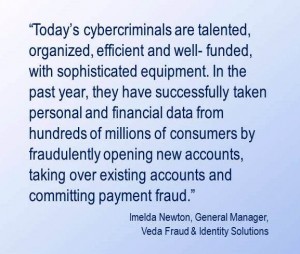 Senior executives from Australia’s big banks, credit unions, card companies, and international financial institutions were joined by Australian law enforcement officials and leading Australian and international anti-fraud experts to discuss new threats in financial services fraud.
Senior executives from Australia’s big banks, credit unions, card companies, and international financial institutions were joined by Australian law enforcement officials and leading Australian and international anti-fraud experts to discuss new threats in financial services fraud.
Global data sourced by Veda from the September quarter 2014[1] showed during the reporting period, 44 per cent of transactions analyzed were from financial services, 31 per cent from e-commerce, and 25 per cent from media customers. An analysis of this data identified attacks had occurred on 1 per cent of financial services, 4 per cent of e-commerce, and 9 per cent of media transactions.
- Financial services attacks typically take place in mobile banking, online banking, online money transfers, lending, brokerage and credit card issuance.
- Attacks in e-commerce environments comprise retail, gambling, gaming and ticketing transactions. Cybercrime attacks which occurred in media include those transactions executed on social networks, content sharing sites and online dating sites.
- The most common means of executing cybercrime are through false account creation, fraudulent payments and theft of logins.
 Cybercriminals are ‘cashing in’ on the habits of consumers who are unwittingly casual with their information as they use the most convenient means possible to complete transactions. While behaviour of Australian consumers makes them vulnerable, they are becoming increasingly concerned, with Veda data showing that 68 per cent of people worry about putting their personal information online [2].
Cybercriminals are ‘cashing in’ on the habits of consumers who are unwittingly casual with their information as they use the most convenient means possible to complete transactions. While behaviour of Australian consumers makes them vulnerable, they are becoming increasingly concerned, with Veda data showing that 68 per cent of people worry about putting their personal information online [2].
The increasing popularity of online shopping and websites that prompt consumers to store their credit card information are easy targets for criminals, who turn stolen identities into cash.
A tendency to use the same password across multiple websites is also an easy in for cybercriminals who find it much more lucrative to use a trusted credit card from a valid customer account, than to reuse a stolen credit card that may have been reported and risk being caught. Not even two factor authentication is safe from the hackers who use Trojans in malware, ‘man in the browser’ and bots to quietly compromise nearly any online authentication system.
Ms Newton says, “The challenge for most financial institutions has shifted from detecting fake account access to stopping valid customers from being caught in the fraud net.”
The data predicts by end of calendar year 2015, 50 per cent of cybercrime attacks will be targeted at mobile devices.
“Mobile account creation represents a large percentage of transactions open to attacks. Some ecommerce companies, particularly in event and travel ticketing where last minute purchases are common, see mobile volumes as high as 80 to 90 per cent of all transactions,” Ms Newton said.
Australia, with the smallest population of all the continents, ranks fourth in rate of cybercrime. Africa, Asia and North America are the most fraudulent regions, while South America and Europe rank fifth and sixth.
The Veda Fraud Focus Group (FFG) comprises Australia’s big four banks, international financial institutions, telecommunications providers, motor vehicle financiers and other credit providers such as credit unions and asset financiers.
Source: Veda Press Release






















